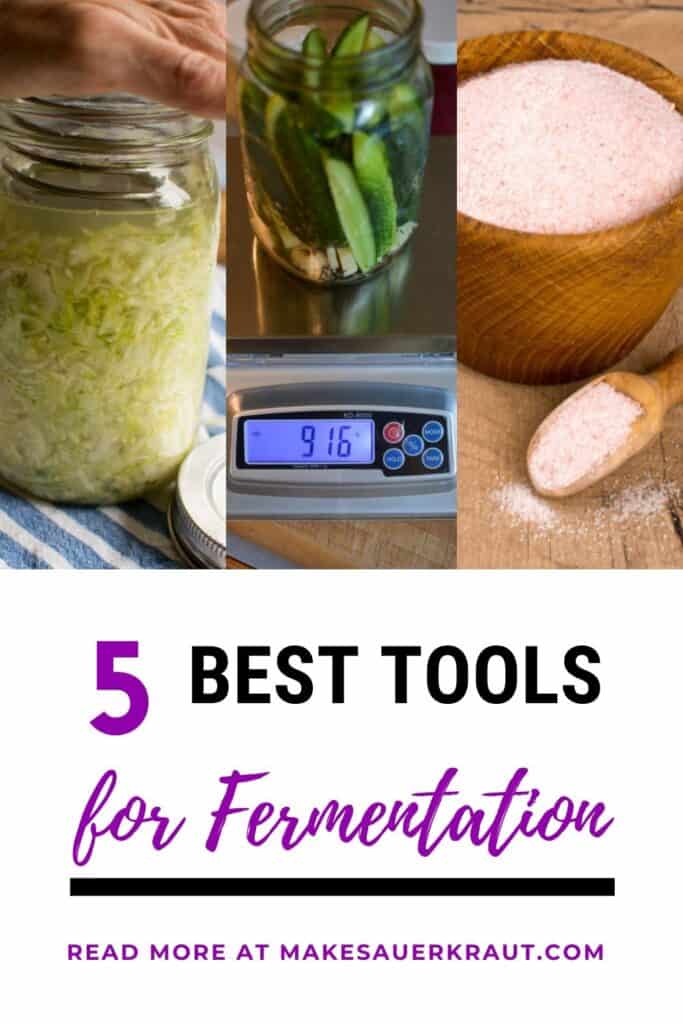Are you getting ready to ferment another batch of mouthwatering sauerkraut, some crunchy carrot sticks, or perhaps some New York style dill pickles?
Over the past 20+ years, after fermenting hundreds of jars of various vegetables, I have come to love a core set of fermentation tools: a digital scale, my handy jars, salt, my favorite weights, and a lid.
These are the tools that I grab every time I get ready to ferment something. But, some brands or styles work much better than others. I’ll share with you the true winners.
Whether you have just started fermenting, or you have been fermenting for years, a few key tools can easily move the needle towards even greater success. Read on to find out the tools I recommend.
1. MyWeigh KD-8000 Digital Scale
Weigh Your Ingredients with Ease
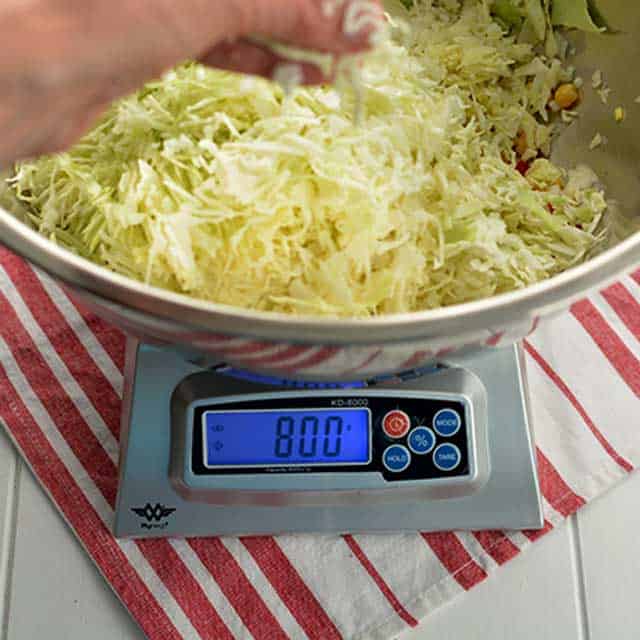
A professional digital scale will take your fermentation to the next level, and… make your life a whole lot easier.
I can’t believe how often the MyWeigh KD8000 scale is used in our household and not just for fermentation. I find it to be a true workhorse that is worth every penny I invested in it. Whether I am fermenting a small batch in a jar or ready to fill my 5-gallon water-sealed fermentation crock, the very first tool I pull off the shelf is my prized digital scale.
When you use a digital scale for fermentation you:
- Slice the right amount of cabbage to fit in your container.
- Add the correct amount of salt to your ferment to ensure a safe fermentation. Since grain sizes vary greatly between salt types and manufacturers, weighing your salt is the most accurate way to add salt to your recipe.
- Can easily adjust future batches to match your specific fermentation temperatures and flavor preferences.
The first scales I used for fermentation were the old-fashioned manual ones. I loved that no batteries were required. However, once I understood the importance of weighing your salt, I bought a simple, inexpensive digital scale.
And, soon discovered the problem with most digital scales.
The first time I used my digital scale, I put my bowl on the scale and hit the tare button to set the display to 0 grams; then as I was slicing cabbage, it turned off. When I turned it back on, it no longer knew the weight of my bowl, and I was forced to dump the contents and start the weighing process over. No fun.
Note: If your digital scale shuts off automatically, be sure to write down the weight of your bowl for future reference.
With a little bit of research, I happened upon the MyWeigh KD8000 scale, a favorite among bread bakers who weigh their ingredients and work by percentages. As with bread bakers, for Fermentation Ninja’s, I recommend weighing your ingredients and adding a set percentage of salt. Easy-peasy with the KD-8000 scale.
I love using the MyWeigh KD-8000 scale because it:
- Can be programmed to not shut off automatically. To conserve battery life, most digital scales are programmed to automatically shut off after a minute or two, erasing any tare reading (the weight of your empty bowl) that you were expecting to make use of. See 7 Reasons Why I Love the MyWeigh KD-8000 Digital Scale [HOW-TOs] for instructions on how to disable the auto-off feature.
- Has a PERCENT (%) key that can take your fermentation to the next level. Once you have all your ingredients in your bowl, you press the % KEY. “100.0” is shown on the display. Then, you slowly add salt until it reaches the desired percentage (102.0 for 2% salt). How easy is that?
- Has an 8000 gram (8 kg, 17.6 pounds) capacity. The capacity of a typical kitchen digital scale is 3000-5000 grams.
- Has an optional AC adaptor that allows you to plug the scale into the wall and save on battery usage.
See 7 Reasons Why I Love the MyWeigh KD-8000 Digital Scale [HOW-TOs] for a complete review of my favorite fermentation tool, a scale. In this post, I also give directions on how to use the percent (%) key.
- PERCENTAGE: Percentage weighing function great for baking and soap making
- MODES: Large, 8000 gram capacity / 4 additional weighing modes: lbs, lbs/oz, oz and kg
- EASY CLEAN: Easy to clean stainless steel platform
2. Quart (Liter) Wide-Mouth Canning Jars
The Perfect Fermentation Vessel with which to Master Fermentation
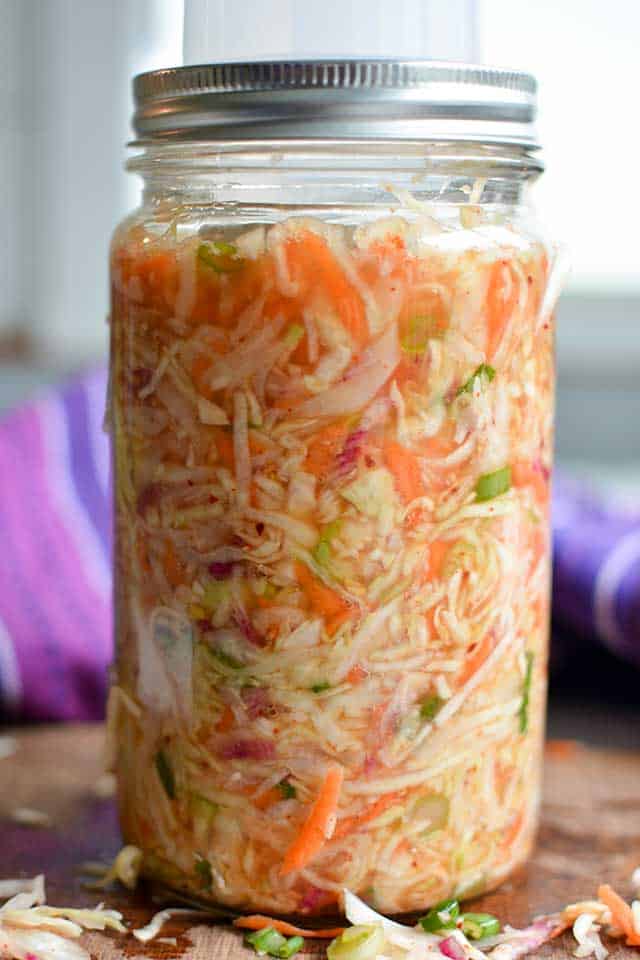
Any brand of glass canning jar is a top pick for me. Just make sure it is wide-mouth and approximately one quart (liter) in size.
This is the container you will be packing your sauerkraut mixture into. The best vessel to use when learning how to make sauerkraut is a glass jar.
Once you can “make sauerkraut in your sleep” using the smaller environment of a jar, you can then “graduate” to making larger batches in a water-sealed stoneware crock.
If you live in an area of the world where canning jars are not easily purchased, repurpose jars that have been used for other food items.
Ideally, find jars that are about the 1-quart (1 L) size and have a wide opening. Jars much smaller than this make it harder to create a strong and healthy fermentation. It is also nice to stick to always using the same size jar in order for quantities to be kept consistent from batch to batch.
Canning jars are great for fermentation because they:
- Are inexpensive to purchase or easy to find used.
- Are clear, which allows you to watch the fermentation process unfold.
- Make it easy to experiment with various recipes or try unusual vegetable combinations.
- Can be used both for fermentation and for storage.
- Fit easily into your refrigerator and can be served out of directly.
Note: Canning jars come in many sizes with both wide-mouth and regular-mouth openings. Be careful when purchasing that you select the right one: Quart (liter) and wide-mouth.
- Ball wide mouth quart jar. The size of the jar is based on filling it to the rim.
- Ideal for preserving jams, jellies sauces, mustard & flavored vinegar
- Custom time tested ceiling compound help ensure a quality seal with each lid
3. Himalayan Pink Salt
Provide the Best Home for the Hard-Working Bacteria
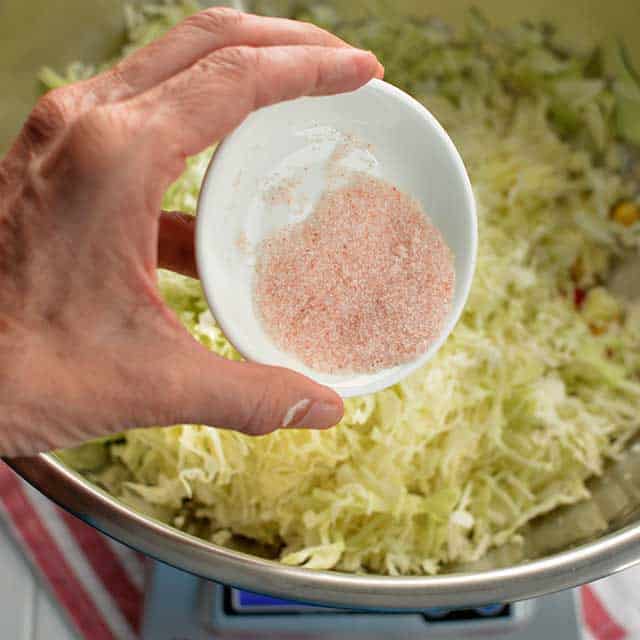
Himalayan pink salt is my favorite fermentation salt. Its purity and high mineral profile ensure a healthy fermentation environment. I especially like its color–a beautiful pink! Himalayan Pink Salt is mined from deep in the Himalayan Mountains. This salt crystallized more than 200 million years ago and remains protected from modern-day pollution and impurities.
Salt is used to create the brine in which the cabbage mixture ferments. Salt pulls water out of the cabbage to create an environment where the good bacteria can grow and proliferate and the bad can bacteria die off.
However, few people realize that this salt–like our sugars, flour, and vegetable oils–is highly refined. It is the product of an industrial process that uses chemicals and high temperatures to remove all the trace minerals naturally occurring in the sea or earth. Those minerals are then sold to companies making and selling dietary supplements. These are the minerals that our bodies use to regulate blood pressure, nourish our adrenals, and just plain keep us healthy.
When selecting a Himalayan pink salt, make sure it comes from Pakistan, the only true source of real Himalayan salt. Expect to pay about $3.50 to $5.00 per pound. Prices much lower than this may be a sign that the salt was collected from higher elevations, rather than the deeper, pure salt mines, and may contain impurities—impurities that you may notice settling to the bottom of your container when dissolving some salt in the water to make a brine.
To ensure that your salt easily dissolves, ideally purchase fine-grain salt. If all you are able to get is a coarse salt sold in a grinder, grind it before measuring.
- Our Sherpa Pink Himalayan Salt is Kosher Certified, Non-GMO, and does not contain any MSG, Soy,...
- This Sherpa Himalayan pink salt is in our slightly larger than standard table salt Fine Grain.
- Our 100% pure Himalayan Pink Salt is the perfect addition to any meal! Sherpa Pink Himalayan...
- FLAVOR – Real Salt is unlike any salt on earth. It’s subtly sweet, never bitter sea salt...
- NATURAL – Unrefined, unprocessed and ancient sea salt with trace minerals and no additives....
- HEALTHY – Recommended by doctors! An ancient sea salt recommended by doctors and health...
My Favorite Tools FREE Download
Say goodbye to the guesswork and hello to deliciously fermented foods with these must-have fermentation tools.
4. Pickle Helix Fermentation Kit & Lid by Trellis + Co.
Rethinking Fermentation Weights
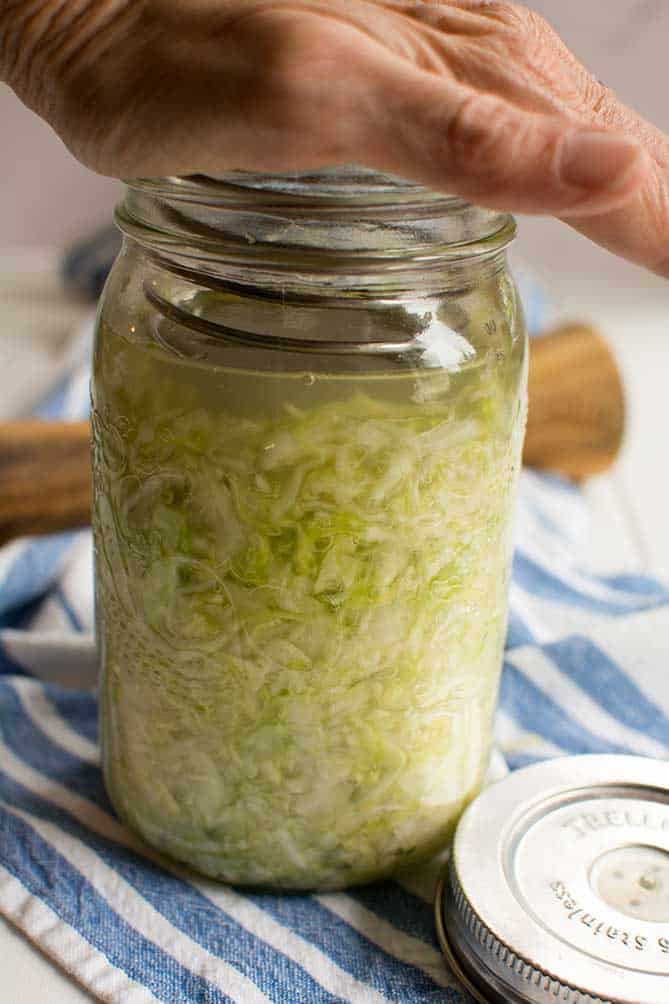
One of the key factors for successful fermentation is keeping everything below the brine safe from molds and pathogenic bacteria.
The currently common use of a fermentation weight is a carryover from fermenting in the large open crocks of yesteryear—where you could place quite a bit of weight onto a plate in your crock—to today’s style of fermenting in a small jar.
With a packed, shredded ferment—as in sauerkraut—the gases produced by the bacteria in the first stage of fermentation can’t always find their way up and out of the jar and instead accumulate in the packed sauerkraut, causing the mixture to expand and move up and out of the brine, sometimes even forcing the brine to overflow the jar. This is called heaving.
You just can’t make a weight that is heavy enough and fits into a small jar.
Enter, a new paradigm.
The use of something that will exert enough downward force on your packed ferment to prevent it from moving up and out of the jar, and… leave plenty of room for brine.
A solution?
A coiled spring.
The PickleHelix is a length of heavy-duty stainless steel wound into a spring that you place on top of your packed ferment. It automatically adjusts to changing ferment volumes and compresses down to the mere thickness of a glass weight if necessary. It works!
I grab my PickleHelix 99% of the time because it:
- Keeps your ferment under the brine for the duration of the fermentation period. Often after the first week, when the active stage has finished, the brine gets pulled back into the cabbage cells, leaving your ferment high and dry. Not so with the PickleHelix.
- Does not displace brine to cause overflows as glass fermenter weights do.
- Is extremely durable and automatically adjusts to changing ferment volumes, compressing down to the mere thickness of a glass weight if necessary.
- Is made from 100% medical-grade (316) stainless steel and will not corrode in an acidic fermentation environment. The most common form of stainless steel is 304 which is susceptible to corrosion from saline solutions, that is, the brine in your ferment!
- Won’t absorb odors. When you use stainless steel or glass, you don’t have to battle removing strong odors of onions, garlic, or tomato, as is the case with plastic or silicone.
- KIT INCLUDES: 3 x 316 Stainless Steel Fermentation Lids with waterless silicone airlocks for...
- FERMENT LIKE A PRO: Pro fermenters use nothing but stainless steel why shouldn’t you? Our...
- WATERLESS AIRLOCKS: We ditched the pool of stagnant pathogen-filled water sitting right over...
Ball also makes a fermentation spring. Their lid is plastic.
- INCLUDED 2 Wide Mouth Fermentation Lids 2 Stainless Steel Spring Fermentaion Weights
- HELPS KEEP OXYGEN OUT The fermentation lid helps keep oxygen out of the jar preventing harmful...
- STAINLESS STEEL FERMENTATION WEIGHT The stainless steel spring keeps food submerged under the...
I’ve tried them all, and have reviewed them all:
Pickle Pipe Pickle Pebble [MasonTops] REVIEW: Delightfully Simple
ViscoDisc Canning Buddies REVIEW [Simple & Affordable]
Pickle-Pushing No-Float Jar-Packer Review: Ingenious
They all work to some degree but there is a clear winner.
If you’re uncomfortable with using stainless steel for fermentation, check out this article where I cover the pros and cons of plastic, glass, stainless steel, etc.
5. Plastic Storage Caps
Simple and Effective
Use for storing sauerkraut or as your lid during fermentation.
Not only do you need a way for gases to escape but you also want to prevent oxygen, bacteria, mold spores, and wild yeasts from entering your jar.
The surface of your ferment is under the brine and will be aerobic, but to reduce the chance of molds and yeasts developing on the surface, we seal the jar with a lid. The type of lid you use will determine how much airflow there is.
Storage caps are one-piece lids sold with or without a rubber or silicone sealing gasket. These lids are sold in the same section as canning supplies. I like their clean look and affordability, and the simplicity of a one-piece lid. This is the lid I use in my teaching recipe and when giving workshops. I also use these lids when storing my sauerkraut.
- Use these plastic caps for versatile storage
- Perfect for the freezer and refrigerator as well as dry storage
- Contains eight reusable wide mouth plastic storage caps
- Dishwasher safe for easy cleaning
- Not safe for canning or microwave use
- BPA - free
BONUS: Benriner Mandoline
Thin, Uniformly-Cut Cabbage Threads with Ease
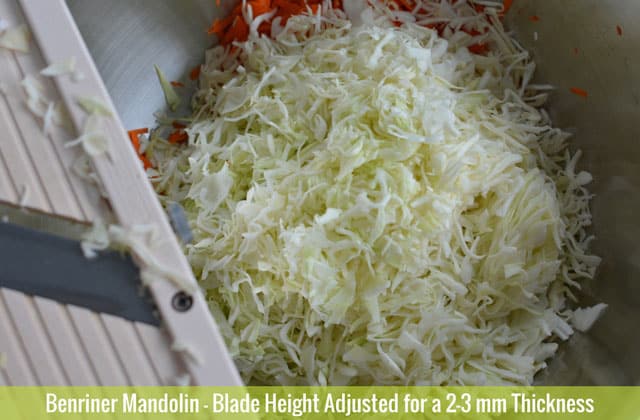
What you use to slice your cabbage will affect how easy it is to slice, what type of slices you will achieve, and what texture and style of sauerkraut you’ll end up with.
A mandoline is a style of slicer that uses a platform made from wood, plastic, or stainless steel to hold one or more razor-sharp blades. Vegetables are placed on the platform and lightly drawn across the fixed blade, allowing you to slice vegetables not only to a uniform thickness but usually much thinner than you could with a knife.
Although it requires less skill to slice vegetables with a mandoline than with a knife, mandolines can be very dangerous, as the angled blades can quickly slice the tip of your finger. Because of this, most mandolines come with a safety guard to protect your hand. For added safety, consider using cut-resistant safety gloves, which are made from a synthetic fabric that is strong, durable, and cut and puncture-resistant.
Walk into the kitchen of any four-star restaurant in the city, and I guarantee you’ll find at least of couple bennies (as they are affectionately called by line cooks) occupying prominent place. Trivia: “Benriner” means “Oh, how handy!” in Japanese. –The Food Lab: Better Home Cooking through Science, J. Kenji López-Al
- 4X STRONGER THAN LEATHER — Made from the highest level of cut resistant material on the...
- 100% FOOD SAFE — Superior grip and a snug fit keep sharp blades securely in your hand —...
- AMBIDEXTROUS — These cut gloves food grade can be worn on either hand, making these...
- Benriner's Beige mandolin slicer easily slices medium fruits and veggies into consistently...
- Made from handcrafted Japanese stainless steel blades and BPA-free plastic; Large open handle...
- 4 interchangeable blades (straight edge, coarse, medium and fine tooth); make wide slices,...
My Favorite Tools FREE Download
Say goodbye to the guesswork and hello to deliciously fermented foods with these must-have fermentation tools.
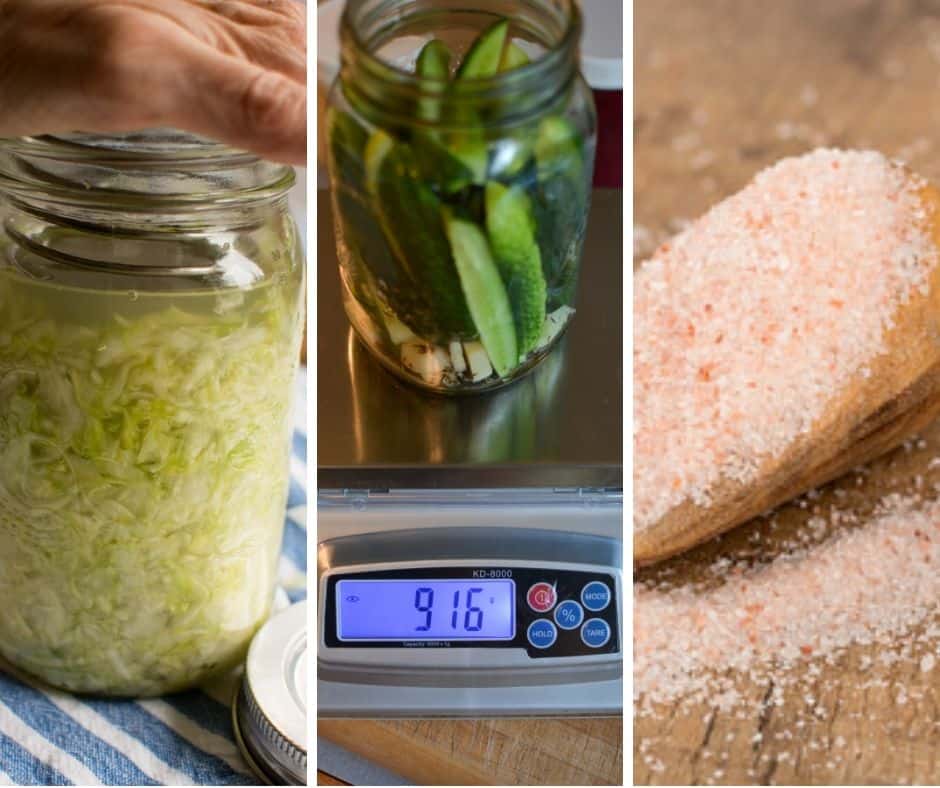
Last update on 2024-07-26 / Affiliate links / Images from Amazon Product Advertising API

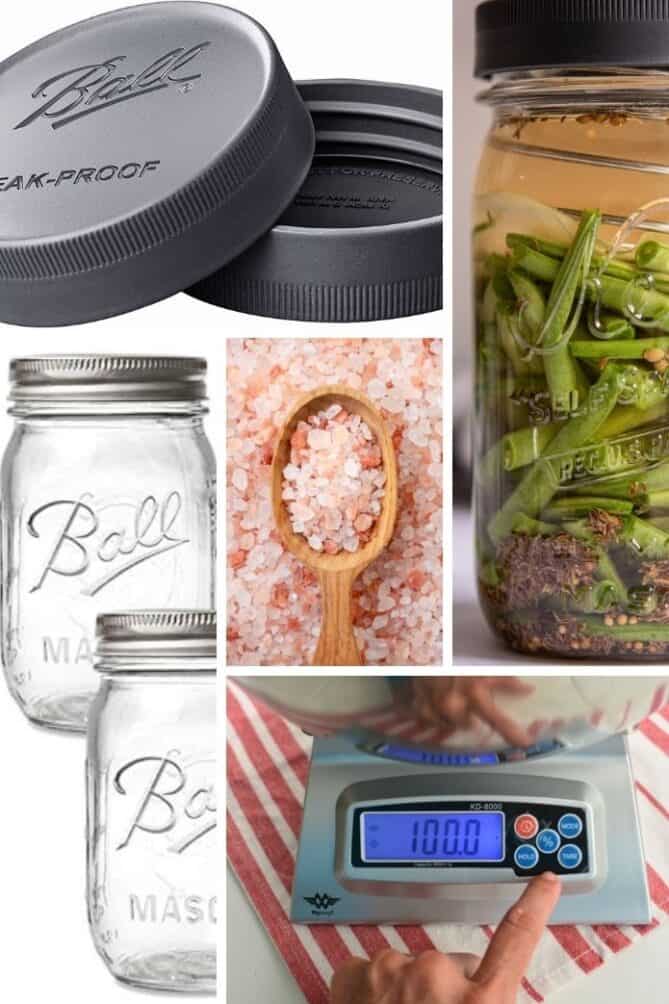

 This post may contain affiliate links which won’t change your price but will share some commission.
This post may contain affiliate links which won’t change your price but will share some commission.